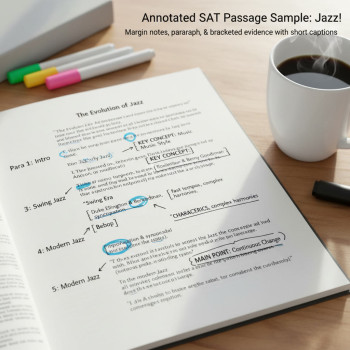Why a Balanced Daily Routine Matters More Than Cramming
Let’s be real: studying for the SAT can feel like a second job. But before you surrender to all-night study marathons, pause. The test rewards steady, deliberate practice and a clear head. A balanced daily routine helps you build skills without burning out, improves retention, and—most importantly—lets you be a student and a human at the same time.
When you create a routine that blends focused study, active rest, and real-life obligations, you transform a stressful race into a sustainable habit. Think of it as building a study ecosystem where practice, reflection, and recovery feed each other.
Principles of an Effective Daily SAT Routine
Before we sketch sample schedules, let’s anchor your routine to a few guiding principles so it actually works when real life shows up.
1. Short bursts beat marathon sessions
Your brain consolidates new information best when exposure is frequent and spaced. Aim for focused blocks of 25–50 minutes, then switch to a short break. This keeps attention sharp and makes it easier to come back the next day.
2. Prioritize quality over quantity
Two hours of deliberate, error-driven practice will beat four hours of unfocused review every time. Use practice tests and error logs to guide what to study next.
3. Mix skills and modes
Rotate between reading/comprehension, grammar, math concepts, and full-section practice. Swap passive reading for active problem solving, timed sets, and review. Variety reduces boredom and strengthens transfer of learning.
4. Include recovery and habits that help
Sleep, nutrition, movement, and brief social time aren’t extras—they’re part of your prep. A well-rested brain is faster at solving algebra, spotting evidence, and staying calm under pressure.
How to Structure Your Day: A Simple Template
Below is a flexible daily template you can customize. It assumes a typical school day; adjust for weekends, holidays, or part-time jobs.
Morning (30–60 minutes): Active Warm-Up
- 10–15 minutes: Quick review of flashcards (vocab, math formulas, common grammar rules).
- 20–30 minutes: One timed, focused practice set (e.g., 10 reading questions or 6 math problems) to get your brain into test mode.
- Optional: Light movement or breathing exercise to wake up your body and focus your attention.
Afternoon (20–40 minutes): Targeted Practice
Between schoolwork or in the late afternoon, do a short targeted session focused on a weak area identified in your error log.
- Example: If you miss algebra structure questions, spend 20 minutes working on 3–4 topic-aligned problems with deliberate review.
- Note: Use solutions to explain mistakes aloud or write them down—this improves memory.
Evening (60–90 minutes): Deep Practice and Reflection
This is your main study block. Split it into two parts:
- 45–60 minutes: Deep work (one full reading passage with timed questions, a math section, or an adaptive Bluebook practice segment).
- 15–30 minutes: Review mistakes thoroughly. Update your error log and write one action you’ll take next time to avoid repeating the error.
Wind-Down (15–30 minutes): Low-Effort Reinforcement
End the day with light, low-stress activities that reinforce learning without strain—listen to a short explanation video, read a short high-quality article, or do flashcards. Then commit to a consistent sleep schedule.
Sample Weekly Plan: Rotate, Don’t Repeat
Rather than repeating the exact same sequence every day, alternate emphases to keep progress balanced. Here’s a sample weekly structure for an 8-week study window.
| Day | Main Focus | Key Activity | Rest/Recovery |
|---|---|---|---|
| Monday | Reading Comprehension | Timed passage + targeted review | 30-min walk |
| Tuesday | Math—Algebra/Functions | Concept drills + error log update | Stretching or yoga |
| Wednesday | Writing & Language | Timed grammar sets + sentence structure practice | Social time with friends |
| Thursday | Mixed Practice | Short adaptive practice session on Bluebook | Relaxed hobby (music, art) |
| Friday | Full Section | One timed Math or ELA section | Movie night or rest |
| Saturday | Full Practice Test (every 2 weeks) | Full-length digital practice (Bluebook) + score analysis | Long outdoor activity |
| Sunday | Light Review & Planning | Review error log, plan next week, organize materials | Family time / mental reset |
How to Use Practice Tests Without Getting Demoralized
Practice tests are the most powerful tool in your kit—but they can also be emotionally heavy. Use this approach to keep them constructive.
- Schedule practice tests every 1–2 weeks early in your preparation, and then every 7–10 days as test day approaches.
- After each test, spend equal time reviewing mistakes as you did taking the test. Identify patterns rather than isolated slips.
- Record two specific goals from each test: one short-term (this week) and one medium-term (next month).
Turn test results into a plan
Don’t just look at the score. Break it down by question type, timing, and mental lapses (was fatigue a factor?). Then assign targeted practice blocks to the areas that will move the needle most.
Timing and Focus: Practical Tips for Digital Testing
The Digital SAT brings a different feel than a paper test. Familiarity with the device, the Bluebook app, and on-screen tools is an advantage.
- Practice on Bluebook so you’re comfortable with navigation and adaptive sections.
- Simulate test day conditions sometimes—silence, strict timing, and a single device for the test—so you learn to manage screen fatigue and pacing.
- Use the digital tools (flagging, highlighting) intentionally; create a personal shorthand for marking tough questions so review is efficient.
Avoiding Burnout: Micro-Routines for Recovery
Burnout is real. Here are micro-routines you can fold into your day to keep your energy steady.
- Micro-movement: 5–10 minutes of stretching or a brisk walk between study blocks.
- Breathing reset: 2–3 minutes of deep breathing before a full-length timed set to reduce anxiety and sharpen focus.
- Brain snack: Healthy carbs and protein before a big study session—fruit and nuts or yogurt work well.
- Sleep anchor: Aim for consistent wake and sleep times, especially in the 2–3 weeks before your test.
Customizing Your Routine: Use Data, Not Guesswork
Everyone’s strengths and schedules differ. Your routine should be a living plan guided by data: practice test results, error logs, and energy patterns across the day.
Create a weekly check-in
Spend 10–15 minutes each Sunday answering three questions:
- What improved this week?
- What still trips me up?
- What one change will I make next week?
Track 3 metrics
Measureable progress helps motivation. Track these simple metrics:
- Average score on timed practice sets per content area.
- Error type frequency (conceptual error, careless mistake, timing issue).
- Sleep consistency (hours and quality) across the week.
How Personalized Tutoring Can Fit Naturally Into Your Routine
Personalized tutoring is not a magic pill, but it does turn time into leverage. A skilled tutor helps you focus on the right weaknesses, gives immediate feedback, and keeps you accountable. If you include tutoring sessions in your routine, treat them as high-value blocks—do the prework, show up with questions, and review the session notes afterward.
For example, Sparkl’s personalized tutoring offers 1-on-1 guidance, tailored study plans, expert tutors, and AI-driven insights that can pinpoint which question types cost you the most time. Integrating a weekly session with a tutor can accelerate the feedback loop and reduce wasted study time—especially in the weeks where small technique changes lead to meaningful score gains.
Example Daily Schedule (School Day) — A Fill-in Template
Copy this template and adapt to your life. Keep one version for weekdays and one for weekends.
| Time | Activity | Purpose |
|---|---|---|
| 7:00–7:30 AM | Flashcards + 10-minute grammar warm-up | Activate memory and build momentum |
| 3:30–4:00 PM | Targeted practice on weakest skill | Deliberate improvement |
| 6:30–7:30 PM | Main study block (timed passage or math set) | Deep learning |
| 7:30–8:00 PM | Review mistakes + update error log | Consolidate learning |
| 9:30–10:30 PM | Wind-down (light reading or video) | Memory reinforcement & prepare for sleep |
Common Roadblocks and How to Fix Them
Every routine hits friction. Here are fixes for typical problems students face.
Problem: I don’t have enough time.
Fix: Shorten study chunks to 20 minutes and add two of them per day. Focus on high-leverage activities—timed practice, error review, and targeted drills.
Problem: I get distracted while studying at home.
Fix: Create a dedicated study zone, put your phone in another room during focused blocks, and use site blockers for social media if needed. The fewer friction points, the more efficient each minute becomes.
Problem: I panic during practice tests.
Fix: Simulate conditions gradually. Start with single timed sections, then progress to full tests. Practice breathing techniques and a simple pacing plan (minutes per question) so your nervous system has a script to follow.
Motivation and Mindset: The Long Game
Scores change slowly but predictably with consistent effort. Think of your study time like a portfolio you keep contributing to. Small, daily investments compound: an hour of deliberate practice five days a week beats one 6-hour binge the night before a test.
Celebrate micro-wins: a week without skipped study, a timed set with fewer careless errors, or a tutor session that clarifies a concept. Positive feedback fuels momentum.
Final Checklist: The Day Before a Practice Test and Test Day
- Day before: Light review only. No new topics. Charge your device and double-check Bluebook installation.
- Night before: Go to bed at your regular time. Avoid heavy screens 30–60 minutes before sleep.
- Test morning: Have a balanced breakfast, hydrate, and do a 10-minute light warm-up (one passage or short math warm-up).
- During test: Pace yourself, flag questions you’ll revisit, and use your practiced breathing reset if anxiety spikes.
Putting It All Together: Your Next 7-Day Sprint
Choose one measurable goal for the week (e.g., reduce careless math errors by 30% or improve average reading set score by 4 points). Follow the daily templates, keep your error log up to date, and book one focused tutor session if you can—Sparkl’s tailored plan and expert feedback can help you make the most of that week by zeroing in on the exact question types costing you points.
Remember: progress in SAT prep is rarely linear. You’ll have plateaus and breakthroughs. The routine matters because it keeps you steady through both.
Closing Thought
Preparing for the Digital SAT is more marathon than sprint. A balanced daily routine doesn’t guarantee a perfect score, but it does guarantee steady improvement, better mental well-being, and the confidence that you’ve prepared in a smart, sustainable way. Build your routine, tweak it, and be kind to yourself along the way—results come to those who plan thoughtfully and persist consistently.
Now take one small step: set up a 25-minute focused block today, pick one weakness from your error log, and make that your target. You’ll thank yourself in a few weeks.














No Comments
Leave a comment Cancel